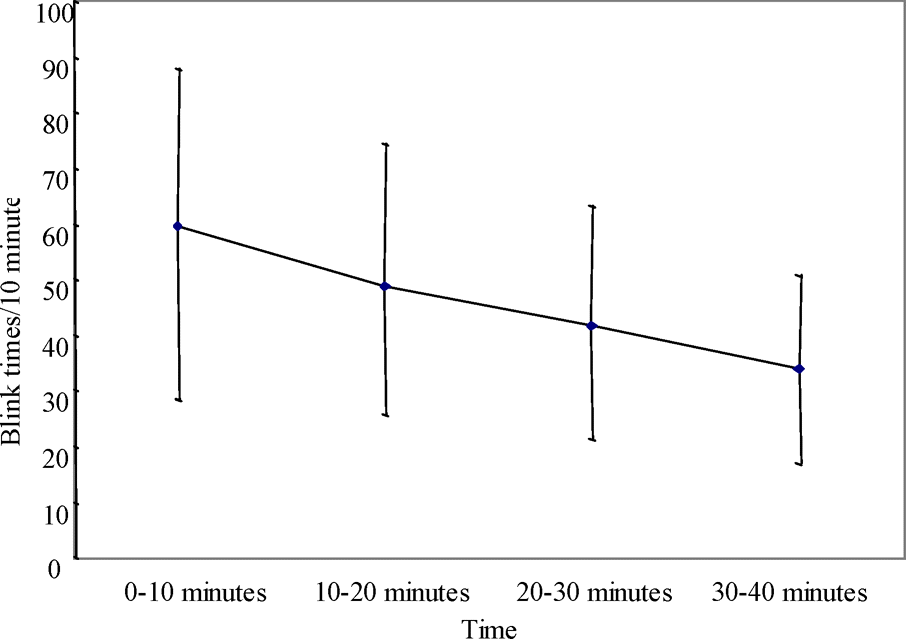Abstract
Purpose
To evaluate the change in blink rate in adolescents according to the type and duration of computer tasks and to analyze the risk of ocular dryness using an ocular protection index.
Methods
Fifteen male high school students played computer games and viewed Internet lectures for 20 minutes each. Blink rate was measured by USB camera, and ocular protection index (OPI, the ratio of BUT to inter-blink interval) was calculated for each subject during the two tasks. In addition, 7 of the 15 subjects played computer games again for 40 minutes on another day, and the change in blink rate according to the duration of computer games was observed.
Results
The average blink rate was 5.44±3.29 per minute (median 5, range 2-12.75) while playing computer games and 20.63±11.21 per minute (median 18.25, range 4.93-42.2) while viewing Internet lectures, and this difference was statistically significant (p=0.001). The percentage of subjects with OPI values less than 1 was 53% for computer games and 13% for Internet lectures (p=0.025). While playing computer games for 40 minutes, the mean of total blinks during ten-minute intervals decreased over time: 59.43 times (median 57) during the first 10 minutes, 33.86 times (median 41) during the last 10 minutes.
References
1. Thompson WD. Eye problems and visual display terminals the facts and the fallacies. Ophthalmic Physiol Opt. 1998; 18:111–9.
2. Boss SR, Calissendorff BM, Knave BG, et al. Work with video display terminal among office employees. III Ophthalmic factors. Scand J Work Environ Health. 1985; 11:475–81.
3. Yaginuma Y, Yamada H, Nagai H. Study of the relationship between lacrimation and blink in VDT work. Ergonomics. 1990; 33:799–809.

4. Cho YA, Won JS, An GJ. The effect on the eye dryness of dye during VDT works. J Korean Ophthalmol Soc. 1996; 37:1991–5.
5. Emory TB, Ousler GW, Abelson MB. All in the blink of an eye. Measuring blink rate and tear film break-up time may help develop new dry eye treatments. Rev Ophthalmol. 2002; 9:82–5.
6. Simmons PA, Vehige JG. Clinical performance of a mid viscosity artificial tear for dry eye treatment. Cornea. 2007; 26:294–302.
7. Kim JH, Kang KT, Cho YA. The influence of the vertical location of VDT screen on the ocular dryness. J Korean Ophthalmol Soc. 1997; 38:1328–35.
8. Park HJ, Yi K. Relationship between middle school students’ computer using time and dry eye. J Korean Ophthalmol Soc. 2002; 43:449–54.
9. Cho YA, Shin JY. The influence of type of computer and VDT work on the dryness of eye. J Korean Ophthalmol Soc. 2002; 43:2280–7.
10. Ishihara I, Ikushima M, Horikawa J, et al. A very low level of magnetic field exposure does not affect a participant's mental fatigue and stress as much as VDT work. J UOEH. 2005; 27:25–40.

11. Yoo JS, Yoon JW, Kim JH. Influence of VDT work on accommodative function. J Korean Ophthalmol Soc. 1992; 33:693–7.
12. Park CJ, Yoo JS, Kim JH. Changes of accommodative function in VDT workers in relation to rest. J Korean Ophthalmol Soc. 1994; 35:790–4.
Table 1.
Blinking rate and inter-blink interval in computer game and internet lecture
Table 2.
Comparison of blink rate, inter-blink interval, and percentage of those having OPI values less than 1 between computer game and internet lecture (mean±standard deviation)
| Computer game | Internet lecture | P value | |
|---|---|---|---|
| Blink rate (times/minute) | 5.44±3.29 | 20.63± 11.21 | P=0.001* |
| Inter-blink interval (second) | 15.43±8.76 | 4.23±3.28 | P=0.001* |
| Percentage of those having OPI values less than 1 | 53% | 13% | P=0.025† |
Table 3.
Changes in the blinking rate and the percentage of OPI less than 1 during 40 minutes of computer games




 PDF
PDF ePub
ePub Citation
Citation Print
Print



 XML Download
XML Download